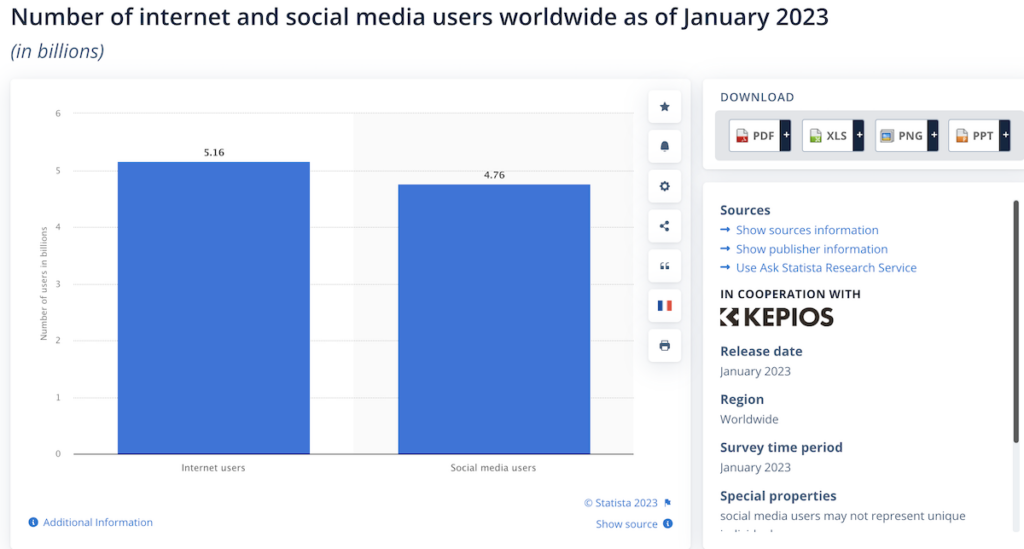In the digital age we live in, the internet has become an integral part of our daily lives. It’s our go-to source for information, communication, entertainment, business and so much more. But have you ever stopped to wonder just how many people are surfing the web alongside you each day? The numbers might surprise you.
In this article, we’re going to delve into the world of internet usage statistics, exploring the sheer scale of daily internet users and what this means for our interconnected world. So, whether you’re a curious individual or a business looking to tap into the digital market, read on to discover the impressive reach of the internet in our daily lives.
How Many People Use Internet Daily: Global Internet Usage

As of January 2023, there were 5.16 billion internet users worldwide, which is 64.4 percent of the global population. This number has been steadily increasing year over year, with no sign of slowing down. Of this total, 4.76 billion, or 59.4 percent of the world’s population, were social media users.
Northern Europe ranked first by the share of the population using the internet in 2023, with 99 percent of the population in Ireland, Norway, Saudi Arabia, and the United Arab Emirates using the internet as of January 2023. At the opposite end of the spectrum is North Korea with virtually no online usage penetration among the general population, ranking last worldwide.
As of 2022, Asia was home to the biggest number of online users worldwide – over 2.9 billion at the latest count. Europe ranked second with around 750 million internet users. China, India, and the United States rank ahead of all other countries by the number of internet users.
Worldwide Internet User Demographics
The share of female internet users worldwide was 63 percent as of 2022, six percent less than that of men. Gender disparity in internet usage was bigger in the Arab States and Africa, with around a ten percent difference. Worldwide regions, like the Commonwealth of Independent States and Europe, showed a smaller gender gap.
As of 2022, global internet usage was higher among individuals between 15 and 24 years across all regions, with young people in Europe representing the most significant usage penetration, at 98 percent. In comparison, the worldwide average for the age group 15-24 years was 75 percent.
The income level of the countries was also an essential factor for internet access, as 92 percent of the population of the countries with high-income reportedly used the internet, as opposed to only 26 percent of the low-income markets.
Internet Usage During the COVID-19 Pandemic
The COVID-19 pandemic has accelerated the adoption of digital technologies worldwide, leading to a significant increase in internet usage. With lockdowns and social distancing measures in place, people turned to the internet for work, education, and entertainment.
According to a report by Hootsuite and We Are Social, the average time spent online per day increased to 7 hours and 29 minutes in 2021. This is an increase of 12.5 percent compared to the previous year.
Social Media Usage
Social media has become an essential part of daily life for many people worldwide. As of January 2023, there were 4.76 billion social media users globally, representing 59.4 percent of the world’s population. Facebook remains the most popular social network, with over 2.8 billion active users.
Social media has transformed the way we connect with others, allowing us to communicate, share information, and form communities around common interests. It has also become a powerful tool for businesses and marketers to reach out to potential customers and promote their products or services.
The Future of Internet Usage
The future of internet usage looks promising, with more and more people gaining access to the internet every day. With the rollout of 5G networks and advancements in technology, we can expect the number of internet users worldwide to continue to grow.
Conclusion
The internet has revolutionized the way we live, work, and communicate. With over 5.16 billion internet users worldwide and counting, it’s clear that the internet is here to stay. The data shows that the internet has become a global phenomenon, with countries all over the world connected to it. Additionally, young people and high-income countries are the most active internet users. We can expect these trends to continue as the internet becomes more accessible to people across the globe.
Frequently Asked Questions
As of January 2023, 64.4 percent of the global population uses the internet.
Northern Europe ranked first by the share of the population using the internet in 2023, with countries like Ireland, Norway, Saudi Arabia, and the United Arab Emirates having a 99 percent internet usage rate.
Young people between 15 and 24 years old represented the highest internet usage across all regions, with young people in Europe having the most significant usage penetration, 98 percent.
As of 2022, the share of female internet users worldwide was 63 percent, six percent less than that of men. Gender disparity in internet usage was bigger in the Arab States and Africa, with around a ten percent difference.
